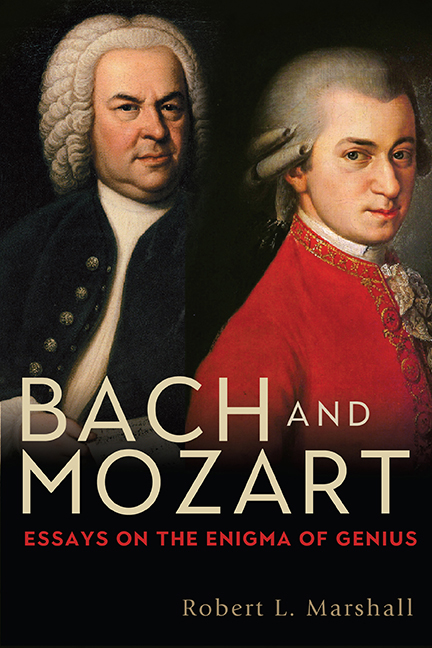Book contents
- Frontmatter
- Dedication
- Epigraph
- Contents
- List of Figures
- Preface
- List of Abbreviations
- Prologue. The Century of Bach and Mozart as a Music-Historical Epoch: A Different Argument for the Proposition
- 1 Young Man Bach: Toward a Twenty-First-Century Bach Biography
- 2 The Notebooks for Wilhelm Friedemann and Anna Magdalena Bach: Some Biographical Lessons
- 3 Bach and Luther
- 4 Redeeming the St. John Passion–and J. S. Bach
- 5 Bach's Keyboard Music
- 6 The Minimalist and Traditionalist Approaches to Performing Bach's Choral Music: Some Further Thoughts
- 7 Truth and Beauty: J. S. Bach at the Crossroads of Cultural History
- 8 Bach at Mid-Life: The Christmas Oratorio and the Search for New Paths
- 9 Bach at the Boundaries of Music History: Preliminary Reflections on the B-Minor Mass and the Late-Style Paradigm
- 10 Father and Sons: Confronting a Uniquely Daunting Paternal Legacy
- 11 Johann Christian Bach and Eros
- 12 Bach and Mozart: Styles of Musical Genius
- 13 Mozart and Amadeus
- 14 Bach and Mozart's Artistic Maturity
- 15 Mozart's Unfinished: Some Lessons of the Fragments
- Epilogue (ossia Postmortem). Had Mozart Lived Longer: Some Cautious (and Incautious) Speculations
- Notes
- Works Cited
- Index
- Miscellaneous Endmatter
- Eastman Studies in Music
5 - Bach's Keyboard Music
Published online by Cambridge University Press: 29 March 2020
- Frontmatter
- Dedication
- Epigraph
- Contents
- List of Figures
- Preface
- List of Abbreviations
- Prologue. The Century of Bach and Mozart as a Music-Historical Epoch: A Different Argument for the Proposition
- 1 Young Man Bach: Toward a Twenty-First-Century Bach Biography
- 2 The Notebooks for Wilhelm Friedemann and Anna Magdalena Bach: Some Biographical Lessons
- 3 Bach and Luther
- 4 Redeeming the St. John Passion–and J. S. Bach
- 5 Bach's Keyboard Music
- 6 The Minimalist and Traditionalist Approaches to Performing Bach's Choral Music: Some Further Thoughts
- 7 Truth and Beauty: J. S. Bach at the Crossroads of Cultural History
- 8 Bach at Mid-Life: The Christmas Oratorio and the Search for New Paths
- 9 Bach at the Boundaries of Music History: Preliminary Reflections on the B-Minor Mass and the Late-Style Paradigm
- 10 Father and Sons: Confronting a Uniquely Daunting Paternal Legacy
- 11 Johann Christian Bach and Eros
- 12 Bach and Mozart: Styles of Musical Genius
- 13 Mozart and Amadeus
- 14 Bach and Mozart's Artistic Maturity
- 15 Mozart's Unfinished: Some Lessons of the Fragments
- Epilogue (ossia Postmortem). Had Mozart Lived Longer: Some Cautious (and Incautious) Speculations
- Notes
- Works Cited
- Index
- Miscellaneous Endmatter
- Eastman Studies in Music
Summary
Johann Sebastian Bach's reputation as one of the supreme figures of Western musical history rests primarily on the legacy of his keyboard music. Whereas the composer's church music and ensemble compositions, including such masterpieces as the Mass in B Minor, the Passions, and the Brandenburg Concertos, fell virtually into oblivion after his death, the Inventions and Sinfonias, the harpsichord suites, the Goldberg Variations, the chorale settings, and the preludes and fugues of The Well-Tempered Clavier have been the objects of unbroken study, veneration, and emulation by gen-erations of musicians—amateur and professional—from Bach's day to the present.
During his lifetime Bach had already been celebrated as the greatest living keyboard player. But it is essential to recognize that for Bach and his contempo-raries, harpsichordists and organists were, more often than not, the same people. In the early eighteenth century, as throughout the seventeenth, the term “clavier” was generic and embraced all keyboard instruments, whether they were attached to strings or pipes. And it followed that a “clavier” player was equally at home on all the available keyboard instruments.
Defining the Repertoire
Naturally enough, during the Baroque era the various keyboard instruments, includ-ing the organ, shared a common repertoire to a significant extent. This is true not only for the earlier masters but also—far more than has generally been acknowl-edged—for much of the “clavier” music of Bach. This means specifically that we must abandon the deeply entrenched “binary” categorization that is literally cen-turies old but nonetheless an anachronistic one. We must recognize, rather, that with regard to performance medium, Bach's keyboard compositions do not fall into two strictly separated categories—consisting of works either for the organ or for the stringed keyboard instruments—but rather into three: works exclusively or primarily for organ, works exclusively or primarily for harpsichord, and works for “clavier,” that is, for any keyboard instrument. Only such a three-part division of Bach's keyboard repertory does full justice to the explicit designations contained in the sources and to the historical circumstances of keyboard performance in the Baroque era.
- Type
- Chapter
- Information
- Bach and MozartEssays on the Engima of Genius, pp. 65 - 113Publisher: Boydell & BrewerPrint publication year: 2019



